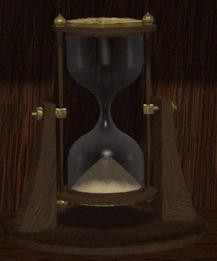 PHEE HOURGLASS
PHEE HOURGLASSThe Phee Hourglass is a relic of the ancient city-state that it is named after. No one has yet to discover the exact nature of the hourglass, but it is generally believed to have been constructed by the Zizbits, the ancient and mysterious cult of sorcerers that dominated Pheebor for several centuries before its razing in 396 BE. This beautiful miniature hourglass was wrought of brass and crystal, and filled with exceptionally fine, white sand.
This artifact was seen on display in the Steppinthrax Monastery museum in 949, but along with most of the relics (probably due to theft) was taken elsewhere. The Phee Hourglass was sold for Zm1000 in 966 GUE to an unknown peasant in Gurth City, but its true value is incalculable.
It was once thought that the Hourglass would remain forever a mystery, part of a greater, unknowable magic. However, in the year 966 GUE a humble peasant-turned-adventurer discovered that with the Hourglass one could travel in time, back to the days of the founding of Pheebor, and forward to the Final Conflagration. The effect was temporary, and the subject would only remain in the displaced era while the sand was falling.
In recent days, one of the most promising sites of recent research in this regard has been the ruins of ancient Pheebor, where the magnificent hourglass monument has offered scholars and adventurers a safe and consistent way to research the past and the future. Since the rediscovery of the monument in the end of the 10th century, most of the argument has centered around the lengths of time that one can travel using the hourglass. Since, at that time, two magical steps into the past were sufficient to return to the last days of Pheebor, it has generally been assumed that each step through the hourglass consists of 681 years forwards or backwards. Although it is possible that the length of the jumps varies depending on certain situations, many scholars have used this figure of seven centuries to arrive at a ballpark age and life expectancy for the world we live in.
However, premature optimism about the future of mankind is tempered by the last era left us by the Pheebor hourglass. The few researchers brave enough to travel ahead as far as 3000 GUE have reported a devastated and ruined landscape. All chronicles referring to this desolate era have called it the Final Conflagration, a deliberate reference to various ancient prophecies that predict all kinds of zorkquakes and fires on the day that the Great Brogmoid finally lies down to sleep.
Another Hourglass
Another hourglass was documented to have been incorporated into the design of the Temple of Agrippa either during the days of its foundation in 668 GUE, or during a latter renovation. Since this hourglass was destroyed with the temple in 949, modern research has been unable to be implemented using the relic, forcing one to rely on the records of the past. Judging from these uncovered documents, while each step of the Phee Hourglass takes one into the past or future by increments of 681 years, this second one was modified so that each step would not bring one into the future or past by a constant number of years, but to specific points in history. Comparing the records in parallel columns, it is evident that some dates were found to match those as given by the Phee Hourglass. Due to these dates, some researchers feel that they cannot conclude that each step of the Phee Hourglass can be proven to be of 681 years. Though due to the frequent testing of the Phee Hourglass, and that there is only one surviving record of the Temple Hourglass, most researchers find the constant of 681 years to be a proven value.